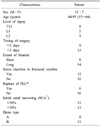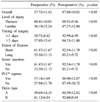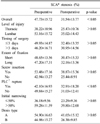Abstract
Purpose
To investigate factors influencing the amount of indirect reduction by ligamentotaxis according to timing of surgery, extent of surgery, and characteristics of fractures.
Materials and Methods
We reviewed 22 cases of thoracolumbar fracture which had been performed posterior instrumentation and fusion using pedicle screw system. We divided patients into each group according to timing of surgery, number of fusion segment, insertion of screw on fractured vertebra, and rupture of posterior ligament complex, and Denis type. We measured changes of kyphotic angle, anterior vertebral height and wedge angle on plain radiographs, and we compared spinal canal area before and after operation using computed tomographic scans.
Results
Kyphotic angle, anterior vertebral height, wedge angle, and area of spinal canal showed significant improvement postoperatively. The wedge angle improved significantly operated within 3 days after injury, however, kyphotic angle and anterior vertebral height had no correlation with variable factors except the rupture of posterior ligament complex. The amount of restoration of spinal canal also affected only by rupture of posterior ligament complex.
Conclusion
There is little relationship between timing of surgery and canal restoration, so we cannot conclude that prompt operation helps reduction of narrowed spinal canal. Otherwise narrowed spinal canal had much less restored by ligamentotaxis when there were rupture of posterior ligament complexes.
Figures and Tables
 | Figure 1Modified Mumford's method to measure spinal canal area on computed tomography using PACS.
(A) Estimated normal spinal canal area, (B) measured spinal canal area.
|
References
1. Aebi M, Etter C, Kehl T, Thalgott J. Stabilization of the lower thoracic and lumbar spine with the internal spinal skeletal fixation system. Indications, techniques, and first results of treatment. . Spine (Phila Pa 1976). 1987. 12:544–551.

2. Dick W. The "fixateur interne" as a versatile implant for spine surgery. Spine (Phila Pa 1976). 1987. 12:882–900.
3. Dick W, Kluger P, Magerl F, Woersdörfer O, Zäch G. A new device for internal fixation of thoracolumbar and lumbar spine fractures: the 'fixateur interne'. Paraplegia. 1985. 23:225–232.

4. Garfin SR, Mowery CA, Guerra J Jr, Marshall LF. Confirmation of the posterolateral technique to decompress and fuse thoracolumbar spine burst fractures. Spine (Phila Pa 1976). 1985. 10:218–223.

5. Gertzbein SD, Crowe PJ, Fazl M, Schwartz M, Rowed D. Canal clearance in burst fractures using the AO internal fixator. Spine (Phila Pa 1976). 1992. 17:558–560.

6. Guerra J Jr, Garfin SR, Resnick D. Vertebral burst fractures: CT analysis of the retropulsed fragment. Radiology. 1984. 153:769–772.

7. Handel SF, Twiford TW Jr, Reigel DH, Kaufman HH. Posterior lumbar apophyseal fractures. Radiology. 1979. 130:629–633.

8. Hashimoto T, Kaneda K, Abumi K. Relationship between traumatic spinal canal stenosis and neurologic deficits in thoracolumbar burst fractures. Spine (Phila Pa 1976). 1988. 13:1268–1272.

9. Kim YT, Kim YJ, Jung JK. Treatment of the unstable thoracolumbar spine fractures using posterior approacxh. J Korean Orthop Assoc. 1995. 30:1670–1679.

10. Kostuik JP. Anterior fixation for burst fractures of the thoracic and lumbar spine with or without neurological involvement. Spine (Phila Pa 1976). 1988. 13:286–293.

11. Kuner EH, Kuner A, Schlickewei W, Mullaji AB. Ligamentotaxis with an internal spinal fixator for thoracolumbar fractures. J Bone Joint Surg Br. 1994. 76:107–112.

12. Kuner EH, Schlickewei W, Kuner A, Hauser U. Restoration of the spinal canal by the internal fixator and remodeling. Eur Spine J. 1997. 6:417–422.

13. Lee JH, Jun DS, Shin WJ, Ahn SJ. The effect of pedicle screw instrumentation on fractured vertebrae in unstable thoracolumbar burst fractures with canal encroachment and clinical result. J Korean Soc Spine Surg. 2006. 13:10–15.

14. Lindahl S, Willen J, Irstam L. Computed tomography of bone fragments in the spinal canal. An experimental study. Spine (Phila Pa 1976). 1983. 8:181–186.
15. Mueller LA, Mueller LP, Schmidt R, Forst R, Rudig L. The phenomenon and efficiency of ligamentotaxis after dorsal stabilization of thoracolumbar burst fractures. Arch Orthop Trauma Surg. 2006. 126:364–368.

16. Mumford J, Weinstein JN, Spratt KF, Goel VK. Thoracolumbar burst fractures. The clinical efficacy and outcome of nonoperative management. Spine. 1993. 18:955–970.




 PDF
PDF ePub
ePub Citation
Citation Print
Print






 XML Download
XML Download